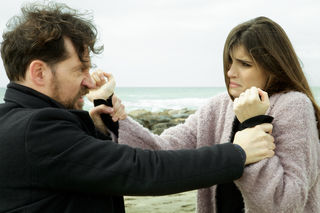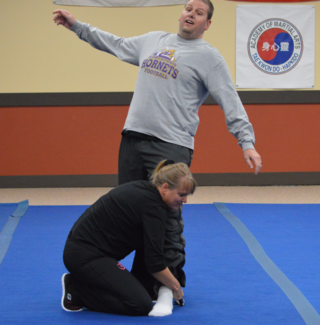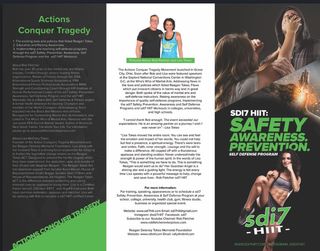Relationships
Protecting Those We Love
Positive actions save lives and conquer tragedy.
Posted November 6, 2018
“Have you ever lost someone you love and wanted one more conversation, one more chance to make up for the time when you thought they would be here forever? If so, then you know you can go your whole life collecting days, and none will outweigh the one you wish you had back.” — Mitch Albom, For One More Day

Here are two stories of loss. Unfortunately, these stories are not unique and are all too common.
This is also a story of how negative energy related to the loss may be redirected into a positive life-saving mission.
Reagan Tokes
Reagan Tokes was a 21-year-old university student, about to graduate and go on to graduate school. On February 8, 2017, shortly after leaving her work shift, Reagan was robbed, raped, abducted, and murdered. After being raped, Reagan was forced to drive to Scioto Grove Metro Park in Grove City, Ohio and to strip naked in the bitter cold. Before being shot twice in the head Reagan's last words would be, "I just want to live.”
Mollie Tibbetts
Mollie Tibbetts was a 20-year old university student about to start her sophomore year in psychology. On July 18, 2018 while jogging near her home in Brooklyn, Iowa, Mollie was abducted and killed by multiple sharp force injuries by an illegal immigrant, 24-year-old Cristhian Bahena Rivera.

Preventable
Both of these deaths were preventable. They were in part, the results of failed systems – the existing laws and policies in the state of Ohio and faulty immigration laws. Reagan’s parents, Lisa and Toby Tokes took immediate action which they label “Action Conquers Tragedy." With tremendous bipartisan support they initiated the Reagan’s Tokes ACT to bring about much needed legislative changes.
Obviously, we can’t simply rely on legislative changes to put an end to homicides. I was fortunate enough to spend some time with Lisa Tokes at a national Who’s Who of Martial Arts Banquet of Legends. Lisa, who is a certified trainer, has teamed up with Martial Artist Master Rob Fletcher, creator of the sdi7 Safety, Prevention, Awareness Self-Defense Program. Together, they are helping educate, raise awareness, and train individuals and groups, especially on university campuses on the importance of quality self-defense programs. When Lisa told her daughter’s story, there was not a dry eye in the house. You could feel the tremendous impact of her experiences. However, this was a presentation to trained martial artists. She was preaching to the believers.

For several years I taught self-defense courses at a university. One survey we conducted showed that over 80% of the people in the class had been a victim of or knew first hand a victim of sexual assault.
Here are a few more statistics:
- At least 1 in 4 females will be sexually assaulted before she finishes four years of college.
- College-aged women are more likely to be targeted.
- Campus rape statistics are highest in the first three months of college.
- 80% know their attacker.
- 55% of victims drank alcohol.
- 74% of assailants drank.
- 95% of all student on student crimes are alcohol and drug-related.
- Freshman, naive, and independent are easy targets for campus victimization.
The sad truth is that attacks on young, college-aged females are frequent and women need to know what to do to stay SAFE. That skill set involves physical fitness, knowledge of certain self-defense techniques and skills, and just as importantly, psychological preparedness including situational awareness.
We have come to think of martial arts as being a fun and worthwhile activity for children and perhaps adults who have maintained this hobby since childhood. Benefits of martial arts are many including: self-control, flexibility, resilience, balance, coordination, respect for others, etc. I have written an article in Psychology Today dealing with this subject which I encourage you to read. I have been involved in martial arts for almost 50 years. It is something in which I am passionate about and appreciate. That being said, there are a lot of martial arts teachers, instructors, and programs out there which are focused on the sport or the art and are really not appropriate to be used for any realistic self-protection. The sport and the art are of enormous value in and of themselves. However, this is typically different and distinct from the skill set and techniques necessary to learn how to defend yourself and stay safe.

Self-Protection
A common misconception is that people learn martial arts because they don’t like the people in front of them. Actually, it’s because we love the people behind us – our friends, family, and loved ones. There are many great self-defense instructors and programs available around the country. In choosing a program, look for descriptions that focus on reality-based or street-based defense. They should incorporate 1) Fitness component – as defending yourself may involve strength, agility, balance and some flexibility. 2) Skill-based component, wherein the techniques emphasize effective over fancy and should rely on some instinctive components. 3) Discussion of appropriate targets. 4) Involve the use of weapons such as sticks, knives, guns, and improvisational weapons which you or an attacker may find on the ground. 5) Create realistic scenarios that one is likely to encounter. This includes not training in a uniform or in bare feet. 6) Strong psychologic component which includes situational awareness, verbal de-escalation, learning to rely on instincts, and managing high stress levels.
Targets
- Primary (most vulnerable): Eyes, Nose, Jaw, Groin.
- Secondary: Throat, Ribs, Top of the foot, Ears, Certain sensitive points on the legs.
Your Natural Weapons
- Thumb strikes. Fingers. Palms. Hammerfists. Elbow strikes. Knees. Kicks. Headbutts.
What Else to Look for in a Self-Protection Program
- Techniques and skills can be done anywhere (home, dorm, apartment, street).
- Physical fitness component integrated into the self-defense skills.
- Designed for women and teenage girls.
- Simple, easy to learn, effective, and instinct-based.
- Skills and techniques practiced repeatedly to build them into muscle memory.
- Spend significant time on psychological aspects, such as: how not to look like a victim, where not to be, how to use your voice to scream or de-escalate dangerous situations.
- Programs are blended. In other words, they are not dedicated to older traditional techniques. They are dynamic; changing, deleting, and incorporating techniques as needed.
General Recommendations
1. Israeli-based self-defense systems such as Krav Maga, Kapap, and my own personal system – Kavanah, are specifically directed toward reality-based self-protection. These systems were initially developed for military personnel and are now taught to civilians, especially women and teenage girls. The systems are eclectic; incorporating Brazilian Jiu Jitsu, Karate, Muay Thai boxing, Philippine Knife and stick defense, and high stress psychological preparations.
2. Combat Hapkido, founded by Grandmaster John Pellegrini 26 years ago and TRU (Tried, Ready and Unafraid) developed by Master Trina Pellegrini are two other reality-based systems which I would highly recommend. Full Disclosure: I am a Combat Hapkido Master Instructor; however, I do not receive any benefits or royalties for new members becoming involved. There are many programs and schools in the United States and around the world. These programs focus on the effective and practical, incorporating joint locks, pressure points and the appropriate verbal skills to help avoid and escape potentially dangerous situations.
3. The sdi7 HIIT Program developed by Master Rob Fletcher as mentioned above is specifically formulated to educate, train and prepare women and teenage girls for a variety of potentially dangerous situations. Master Fletcher has been working with Lisa Tokes to take this program national-wide. The objective of this program is to sculpt, tone, build lean muscle, burn calories and torch fat while learning valuable fighting skills and self-defense. The program consists of a series of 7-minute intervals. One minute on a fighting skill or self-defense technique followed by one minute of an exercise, strength or explosive movement. Doing this for 7 straight minutes with a 1-2 minute rest of 3-5 rounds. The program includes modification and progressions dependent on one’s fighting skills and fitness level. Author of America's Next Great Trainer Transform Your Life.


Safety & Self Defense Tips – as taught by Master Rob Fletcher, GM Farber (author), GM John Pellegrini and Master Trina Pellegrini:
- We should all adhere to daily common-sense safety practices, habits and behaviors. This is especially true of women and teenage girls who are at greatest risk.
- Avoid being complacent. The "it will never happen to me attitude". Prevention will always be your best self-defense.
- Think ahead. Don't be caught unexpectedly in a bad place at a bad time with bad people.
- If attacked, avoid the “Red Mindset” zone – paralyzed by fear and enter the “Green Mindset” zone – GO! Take action – use pepper spray, scream, attack, run.
- Practice verbal skills as realistically and as often as physical skills.
- Learn where and how to strike – before an attack occurs.
- Trust your instincts. If something doesn't feel right, it probably isn't
- Examples of situational awareness:
a. Jog with a friend or go in a group.
b. Jog/Walk in well-lit and populated areas.
c. Avoid jogging/walking in unknown or isolated trails/paths.
d. Avoid late night walks/jogs.
e. If early morning or late-night walks/jogs cannot be avoided travel in well-lit and public areas.
f. Communicate to family members or friends your path, and expected time of return.
g. Avoid headphones. Listen, be aware.
h. Mix up the time of your walks/jogs and the path of travel.
i. Carry Pepper Spray. Hold it in your hand, ready to go. Practice using it.
j. Avoid looking down and talking on your phone when walking in unfamiliar locations.
k. Try to avoid going to an ATM by yourself at night.
l. Don’t post your up-to-date social activities on social media.
m. Don’t create posts such as “Going out of town tomorrow (and leaving all my precious items in my unattended house)."
Teaching your loved ones and the important people in your family self-defense is a life-saving gift. In addition to the high value of safety, the empowerment, self-esteem and decrease stress that comes from being able to protect yourself is priceless.
- Follow me on Twitter and on instagram@thekeytoachieve
- Like my Facebook page, "The Key to Achieve"
- Check out my newest book, Throw Away Your Vision Board: The Truth About the Law of Attraction
- Check out my book, Making Lemonade: 101 Recipes to Convert Negatives into Positives
- Visit TheKeytoAchieve.com




